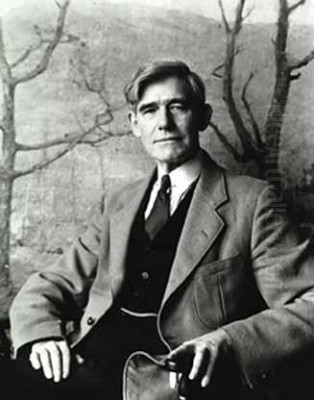
Chauncey Foster Ryder stands as a significant figure in early 20th-century American art. Active as a painter, etcher, and illustrator, he carved a distinct niche for himself, primarily through his evocative landscape paintings. Born in 1868 and passing away in 1949, Ryder's career spanned a period of dynamic change in the art world. His work skillfully blended elements of Impressionism with the more introspective mood of Tonalism, resulting in a style uniquely his own, celebrated for its textural richness and emotional depth.
Early Life and Formative Education
Chauncey Foster Ryder's journey into the art world began in New England. Born in Danbury, Connecticut, in 1868, he spent his early years in nearby New Haven. His artistic inclinations led him westward in his twenties. Seeking formal training, Ryder moved to Chicago, a burgeoning center for arts and culture at the time.
In 1891, he enrolled at the prestigious Art Institute of Chicago, an institution that provided foundational training for many prominent American artists. His time in Chicago was crucial for honing his basic skills and exposing him to the academic traditions prevalent in American art education. He is also noted to have studied at the Smith Art School in Chicago, further solidifying his technical grounding before venturing abroad for advanced studies.
Parisian Studies and Artistic Evolution
Seeking broader horizons and exposure to European art movements, Ryder traveled to Paris in 1901. This move was pivotal, placing him in the heart of the international art scene. In Paris, he enrolled at the renowned Académie Julian, a private art school famous for attracting international students and offering an alternative to the official École des Beaux-Arts.
At Académie Julian, Ryder studied under the guidance of respected figures like Jean-Paul Laurens and Raphael Collin. Laurens, known for his large-scale historical and religious paintings executed in a precise, academic style, likely imparted a sense of discipline and compositional structure. Raphael Collin, on the other hand, was more associated with decorative painting and idealized female figures, but also engaged with landscape elements, potentially encouraging Ryder's burgeoning interest in nature.
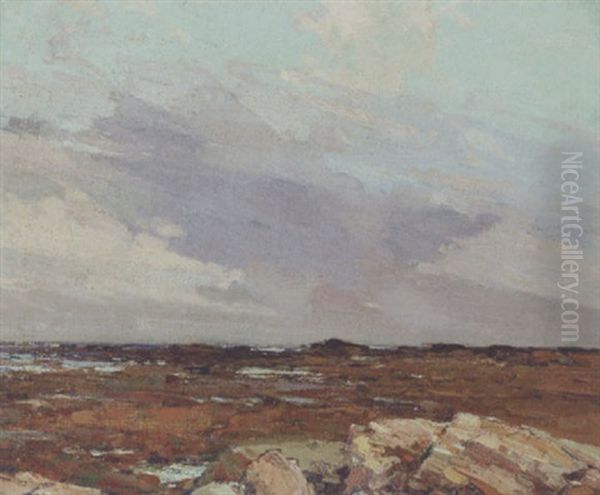
His time in Paris was transformative. Ryder absorbed the influences swirling around him, including the lingering effects of Impressionism and the emerging Post-Impressionist sensibilities. While early works might show subtle nods to the aestheticism of artists like James Abbott McNeill Whistler, his Parisian experience pushed him towards a bolder, more personal style. He began experimenting with more vigorous brushwork and a richer, more nuanced palette.
Ryder's talent gained recognition during his time abroad. He began exhibiting his work, making his debut at the prestigious Paris Salon. A significant milestone came in 1907 when he received an Honorable Mention at the Salon, a mark of distinction that significantly boosted his reputation both in Europe and back in the United States. His European experience wasn't confined to Paris; he also traveled through Italy, the Netherlands, and other parts of France, absorbing diverse landscapes and artistic traditions that would enrich his visual vocabulary.
Return to America and the Mature Style
In 1907, Chauncey Foster Ryder returned to the United States, bringing with him the experiences and artistic developments forged during his years in Europe. He chose to establish his primary residence and studio not in a major metropolis initially, but in the scenic, rural setting of Wilton, New Hampshire. This decision proved deeply influential on his art, as the landscapes of New England, particularly the rolling hills, forests, and farms of New Hampshire, became his most enduring subject matter.
While maintaining connections with the New York art world, often keeping a studio there, the tranquility and rugged beauty of Wilton provided constant inspiration. It was here that Ryder fully developed his signature style. His work from this period is often characterized as a blend of Tonalism and a modified Impressionism. He shared with Tonalist painters like Henry Ward Ranger an interest in capturing mood, atmosphere, and the poetic qualities of nature, often favoring subdued light and harmonious color schemes.
However, Ryder distinguished himself through his distinctive technique. He employed bold, expressive brushwork and often used impasto, applying paint thickly to create a tangible surface texture. This approach gave his landscapes a robust, almost sculptural quality, differentiating them from the more delicate surfaces often associated with Impressionism or the smoother finishes of academic Tonalism. His paintings frequently evoke a sense of quiet contemplation, sometimes tinged with a feeling of solitude or gentle melancholy, reflecting a deep, personal connection to the natural world.
Artistic Techniques and Diverse Mediums
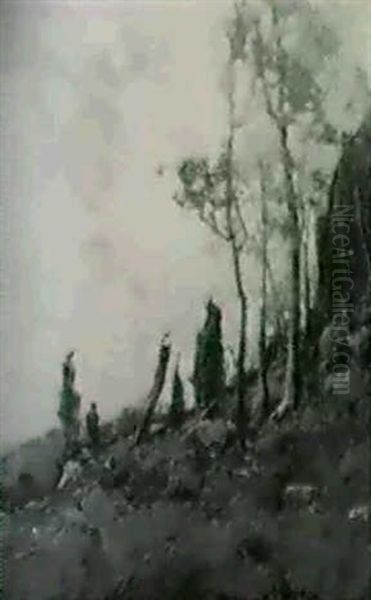
Chauncey Foster Ryder was a versatile artist, proficient across several mediums, though he is best known for his oil paintings. His approach to oil painting was characterized by a confident handling of materials and a focus on capturing the essential character and mood of a scene rather than photographic detail. His use of impasto was notable, building up layers of paint to create texture that enhanced the visual and tactile experience of the work.
His brushwork was often vigorous and direct, defining forms with energy and suggesting light and shadow through contrasting tones and colors. While influenced by Impressionism's focus on light and Tonalism's emphasis on atmosphere, Ryder forged a personal synthesis. His palette could range from muted, earthy tones, characteristic of Tonalism, to brighter, more vibrant colors when depicting specific light conditions or seasons, showing an Impressionistic sensitivity.
Beyond oil painting, Ryder was an accomplished printmaker, particularly skilled in etching and drypoint. His etchings often mirrored the subjects of his paintings – intimate views of the New England landscape, featuring trees, hills, and rural structures. Works like the etching Cutting the Pines showcase his ability to translate his painterly concerns into the linear medium of printmaking, achieving rich tonal variations and atmospheric effects. He was also known to work in lithography and watercolor, demonstrating a broad technical facility. His membership in organizations like the American Watercolor Society and the Society of American Etchers underscores his commitment to these mediums.
Themes and Signature Subjects
The predominant theme throughout Chauncey Foster Ryder's mature work is the American landscape, specifically the rural environment of New England. He was drawn to the pastoral beauty of New Hampshire, capturing its wooded hillsides, winding country roads, weathered barns, and tranquil pastures. His paintings often focus on the interplay between nature and the subtle signs of human presence within it.
Ryder's landscapes are rarely just topographical records; they are imbued with emotion and atmosphere. He excelled at depicting different times of day and varying weather conditions, capturing the soft light of dawn, the hazy warmth of summer, or the stark beauty of winter. A sense of quietude pervades many of his works, inviting contemplation. Some pieces, however, explore more desolate or rugged aspects of nature, reflecting a Romantic sensibility towards the untamed elements of the landscape.
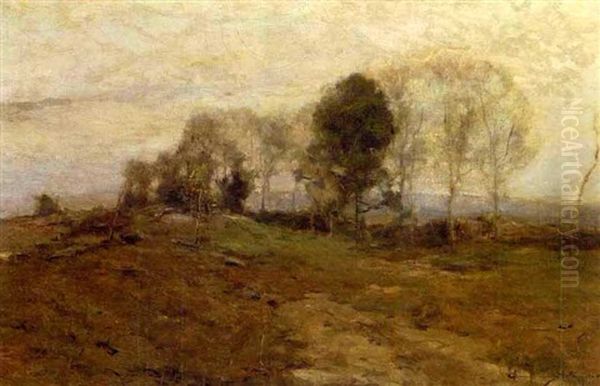
Several works stand out as representative of his style and thematic concerns. Cape Porpoise (1912) likely captures a coastal scene, showcasing his ability to handle light on water. On the Mountain Side (1923) exemplifies his engagement with the New Hampshire terrain. The Willow, exhibited in 1911, suggests his interest in specific natural forms as focal points. Paintings like Bend of the Road and The Old Road to Frameston highlight his recurring motif of pathways leading the viewer into the landscape, symbolizing perhaps a journey or the passage of time. These works collectively demonstrate his consistent focus on capturing the soul of the New England countryside.
Professional Life and Recognition
Throughout his career, Chauncey Foster Ryder actively participated in the American art world, exhibiting his work regularly and engaging with various artistic organizations. His talent earned him significant recognition and numerous accolades. He was elected an Associate of the prestigious National Academy of Design (NAD) in 1914 and became a full Academician in 1920, signifying his acceptance into the highest ranks of the established art community.
His association with the NAD brought further honors. In 1933, he was awarded the Benjamin Altman Prize (specifically, the Second Altman Prize for Landscape Painting), a major award given at the Academy's annual exhibitions. This prize cemented his reputation as one of the leading landscape painters of his generation. Further international acclaim came in 1937 when he received a Gold Medal at the Paris International Exposition, demonstrating his continued standing on the global stage decades after his initial studies there.
Ryder was also an active member of other important groups, including the American Watercolor Society, the Society of American Etchers (later known as the Society of Graphic Artists), the New York Watercolor Club, the National Arts Club, the California Printmakers, and the American Federation of Arts. His involvement in these diverse organizations reflects his broad artistic interests and his engagement with fellow artists across different mediums and regions. His works were frequently included in major national exhibitions, ensuring his visibility and influence within the American art scene for decades.
Contemporaries and the Artistic Milieu
Chauncey Foster Ryder worked during a vibrant period in American art history, bridging the gap between 19th-century traditions and the burgeoning modernism of the 20th century. His style situated him alongside other artists exploring Tonalism and Impressionism, but with a distinctly American sensibility. He was a contemporary of artists associated with the Tonalist movement, such as Henry Ward Ranger, whom sources suggest influenced him, and others like Dwight Tryon and Thomas Wilmer Dewing, although Ryder's approach was generally more robust and less ethereal than theirs.
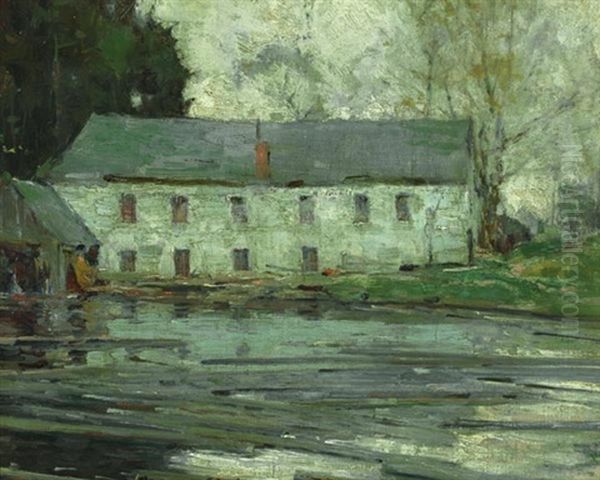
His time in Paris placed him in proximity to numerous international artists. Fellow American students in Paris might have included figures like Max Bohm. His later professional life saw him exhibiting alongside a wide range of American artists. The list provided in the source material, mentioning figures like Leopold G. Seyffert, Henry Ossawa Tanner, and Frederick Ballard Williams, likely represents artists who were fellow members of organizations like the NAD or exhibited in the same venues. Tanner, an acclaimed African American painter known for his religious scenes and Orientalist subjects, represents the diversity of styles present during Ryder's active years. Williams was known for his decorative landscapes often featuring idealized figures.
Ryder's landscape focus connects him to the long tradition of American landscape painting, stretching back to the Hudson River School painters like Thomas Cole and Frederic Edwin Church, though Ryder's style was vastly different, shaped by European influences they predated. He also worked concurrently with American Impressionists like Childe Hassam and John Henry Twachtman, who similarly found inspiration in the New England landscape, but often with a brighter palette and more broken brushwork. Artists like Arthur Parton and Francis Augustus Silva, active slightly earlier but overlapping with Ryder's early career, also explored landscape themes, sometimes incorporating influences from French Barbizon painting or Luminism. John La Farge, a multifaceted artist known for stained glass as well as painting, was another significant contemporary figure in the broader American art scene. Ryder navigated this complex artistic landscape, developing a personal voice that resonated with both traditional and progressive elements of his time.
Legacy and Museum Collections
Chauncey Foster Ryder's contribution to American art lies in his distinctive interpretation of the landscape, characterized by its blend of Tonalist mood and Impressionist-influenced technique, executed with a signature textural quality. His work offered a poetic, often introspective view of nature, particularly the New England countryside, which resonated with audiences and critics alike. His influence extended to other artists, as evidenced by the mention of printmaker William Jameson finding inspiration in Ryder's drypoint etchings.
The enduring importance of Ryder's work is confirmed by its presence in the permanent collections of major American museums. Esteemed institutions holding his paintings and prints include the Metropolitan Museum of Art in New York, the Art Institute of Chicago, the Cleveland Museum of Art, the Brooklyn Museum, the Philadelphia Museum of Art, and the Pennsylvania Academy of the Fine Arts, among others. This widespread institutional recognition underscores his significance in the canon of American art.
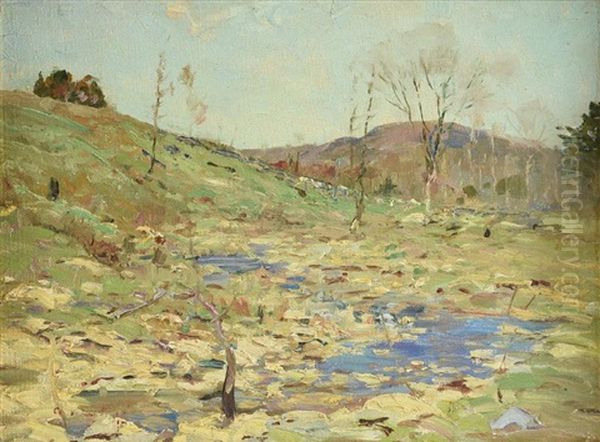
Furthermore, the continued interest in his work is reflected in the art market. The respectable price achieved for a painting like The Old Road to Frameston at auction indicates that collectors and connoisseurs still value his unique artistic vision and technical skill. His legacy is that of a dedicated landscape painter who captured the essence of a specific American region while contributing a personal and emotionally resonant style to the broader narrative of early 20th-century art.
Critical Reception and Influence
Academic and critical assessment of Chauncey Foster Ryder generally positions him as a key figure within the later phase of American Tonalism, successfully integrating elements learned from European movements into a distinctly American landscape idiom. Critics often praise the poetic and evocative quality of his work, highlighting his ability to convey mood and atmosphere through his sensitive handling of light, color, and composition. His bold brushwork and use of impasto are frequently noted as defining characteristics that lend his paintings a strong physical presence and tactile appeal.
His work has been described as a form of "thought painting," suggesting that his landscapes transcend mere representation to explore inner states or emotional responses to nature. This aligns him with the subjective and expressive tendencies seen in late 19th and early 20th-century art, moving beyond strict realism. He is recognized as an important post-Impressionist figure in the American context, demonstrating how international styles were adapted and personalized by American artists.
While largely lauded, his work occasionally faced criticism. Some contemporary and later critics may have found his style overly subjective or perhaps lacking the formal rigor associated with more academic or, conversely, more avant-garde approaches. This occasional critique, however, also points to the very individuality and expressive freedom that characterize his art. Overall, the consensus acknowledges Ryder as a talented and influential artist whose work significantly contributed to the richness and diversity of American landscape painting in his era.
Conclusion
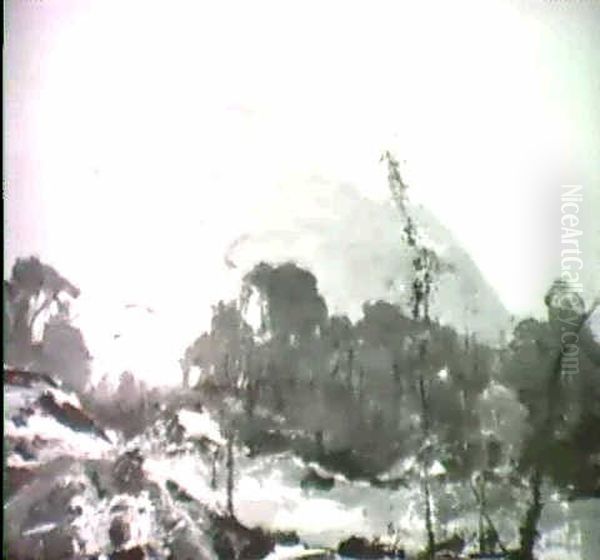
Chauncey Foster Ryder remains an important and respected figure in American art history. Through a career dedicated primarily to landscape painting, supplemented by accomplished work in printmaking and watercolor, he developed a highly personal style. Synthesizing the atmospheric concerns of Tonalism with the textural and chromatic interests emerging from Impressionism and Post-Impressionism, he created evocative portrayals of the New England countryside. His bold technique, combined with a sensitive rendering of mood and light, resulted in works that are both visually compelling and emotionally resonant. Recognized with significant awards and represented in major museum collections, Ryder's art continues to be appreciated for its unique contribution to the American landscape tradition and its enduring capture of the spirit of place.